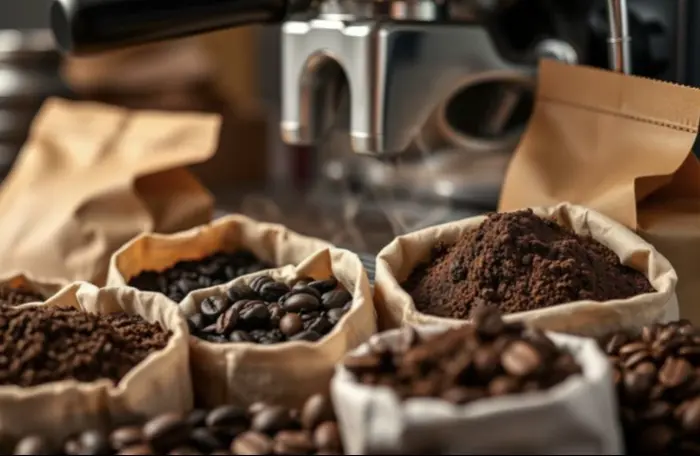When it comes to coffee, many people wonder if ground espresso is the same as regular ground coffee. The short answer is no—they are not the same. While both come from coffee beans, differences in grind size, roast level, and brewing methods set them apart.
In this article, we will explore the distinctions between ground espresso and ground coffee. We will cover their origins, preparation methods, flavor profiles, and best uses. By the end, you will have a clear understanding of how they differ and which one suits your brewing style.
What Is Ground Coffee?
Ground coffee refers to coffee beans that have been roasted and ground to a specific consistency. It is a broad term that includes different grind sizes suitable for various brewing methods.
Types of Ground Coffee
Ground coffee can be categorized based on grind size:
Coarse grind: Used for French press and cold brew.
Medium grind: Ideal for drip coffee makers and pour-over methods.
Fine grind: Best for espresso and Moka pots.
Extra-fine grind: Used for Turkish coffee.
The grind size affects extraction, influencing flavor and strength. A coarser grind results in a lighter extraction, while a finer grind produces a stronger, more concentrated brew.
Roast Levels
Ground coffee comes in different roast levels:
Light roast: Bright, acidic, with more pronounced fruity or floral notes.
Medium roast: Balanced flavor with mild acidity and sweetness.
Dark roast: Bold, smoky, and bitter, with less acidity.
The roast level impacts the taste, but the brewing method also plays a crucial role in the final cup.
What Is Ground Espresso?
Ground espresso is a type of ground coffee, but it is specifically designed for espresso machines. It has distinct characteristics that make it different from regular ground coffee.
Grind Size
Espresso requires an extra-fine grind, much finer than drip coffee. This fine texture allows high-pressure water to extract flavors quickly, producing a concentrated shot.
If the grind is too coarse, the water will pass through too quickly, resulting in a weak, under-extracted shot. If it’s too fine, the water may struggle to pass, leading to over-extraction and bitterness.
Roast Profile
Espresso beans are typically roasted dark, but medium roasts are also common. The darker roast enhances the bold, rich flavors needed for espresso. However, some specialty coffee shops use lighter roasts for a brighter, more complex espresso.
Brewing Method
Espresso is made using an espresso machine, which forces hot water (around 9 bars of pressure) through finely-ground coffee. This process creates a thick, syrupy liquid with a layer of crema—a golden foam on top.
Key Differences Between Ground Espresso and Ground Coffee
Now that we understand the basics, let’s break down the main differences.
Grind Size
Espresso: Extra-fine, almost powdery.
Drip coffee: Medium to coarse, depending on the brewing method.
Using the wrong grind size can ruin your coffee. For example, if you use coarse ground coffee in an espresso machine, the shot will be watery and weak.
Brewing Pressure
Espresso: Requires high pressure (9 bars or more).
Drip coffee: Uses gravity or low-pressure extraction.
The high pressure in espresso machines extracts oils and solubles quickly, creating a rich, full-bodied drink.
Flavor and Strength
Espresso: Intense, bold, and concentrated with a creamy texture.
Drip coffee: Lighter, smoother, and more diluted.
Espresso has a thicker mouthfeel due to its high concentration of dissolved solids.
Caffeine Content
Many assume espresso has more caffeine than drip coffee, but this isn’t entirely true.
Espresso (per ounce): Higher caffeine concentration (about 63 mg per shot).
Drip coffee (per cup): More total caffeine (about 95–200 mg per 8 oz).
Since espresso is consumed in smaller amounts, a single shot has less caffeine than a full cup of drip coffee.
Crema
Only espresso produces crema, the golden-brown foam on top. This is a result of emulsified coffee oils and carbon dioxide released under high pressure.
Can You Use Ground Espresso for Regular Coffee?
Yes, but with some considerations.
In a Drip Coffee Maker
Using fine espresso grounds in a drip machine can lead to over-extraction and a bitter taste. The water moves too slowly through the fine particles, extracting unwanted flavors.
In a French Press
Espresso grounds are too fine for a French press, leading to a muddy texture and sediment in the cup.
In a Moka Pot
A Moka pot works well with espresso grind because it uses pressure similar to an espresso machine, though at a lower level.
Can You Use Regular Ground Coffee for Espresso?
Technically, yes, but the results may disappoint.
In an Espresso Machine
If the grind is too coarse, the water will flow too fast, producing a weak shot. Some espresso machines can adjust pressure, but for best results, an extra-fine grind is necessary.
As a Substitute
If you don’t have espresso grounds, you can use a fine grind of dark roast coffee. It won’t be perfect, but it can work in a pinch.
Which Should You Choose?
Your choice depends on your brewing method:
For espresso machines: Use ground espresso.
For drip, French press, or pour-over: Use medium or coarse ground coffee.
If you enjoy both, consider buying whole beans and grinding them as needed for freshness.
Conclusion
Ground espresso and ground coffee are not the same. Espresso requires a finer grind and is brewed under high pressure, resulting in a concentrated, bold flavor. Regular ground coffee has a coarser texture and is suited for methods like drip brewing or French press.
Understanding these differences helps you choose the right coffee for your preferred brewing style. Whether you enjoy a smooth drip coffee or a rich espresso shot, using the correct grind ensures the best flavor in every cup. By selecting the right grind and roast, you can elevate your coffee experience and enjoy each sip to the fullest.
Related topics:
What is the Best Espresso Powder for Baking?
How to Grind Coffee Beans for Espresso Without a Grinder


